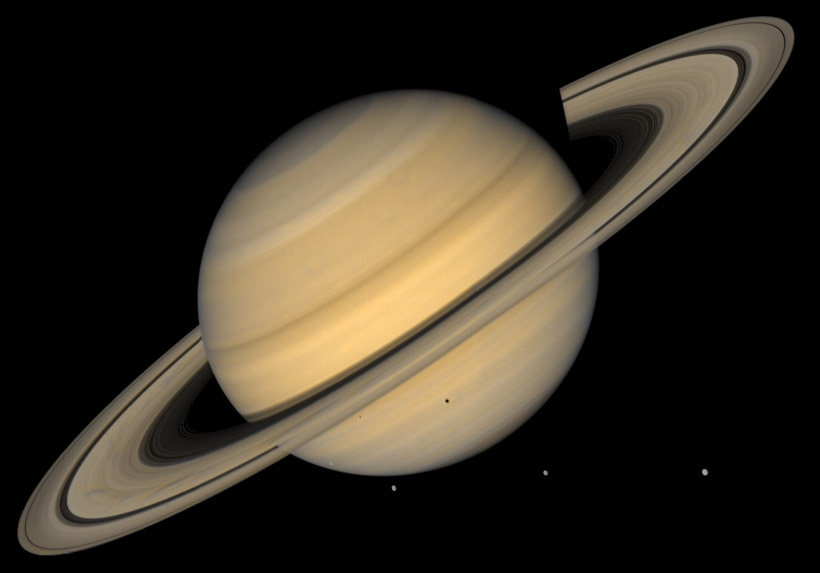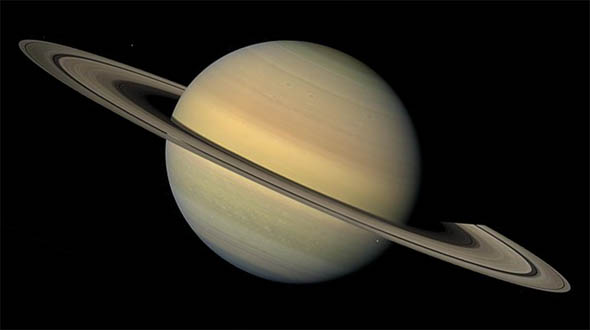You are here: Solar System → Saturn
10 Need-to-Know Things About Saturn
- If the sun were as tall as a typical front door, the Earth would be the size of a nickel and Saturn would be about as big as a basketball.
- Saturn orbits our sun, a star. Saturn is the sixth planet from the sun at a distance of about 1.4 billion km (886 million miles) or 9.5 AU.
- One day on Saturn takes 10.7 hours (the time it takes for Saturn to rotate or spin once). Saturn makes a complete orbit around the sun (a year in Saturnian time) in 29 Earth years.
- Saturn is a gas-giant planet and does not have a solid surface.
- Saturn's atmosphere is made up mostly of hydrogen (H2) and helium (He).
- Saturn has 53 known moons with an additional 9 moons awaiting confirmation of their discovery.
- Saturn has the most spectacular ring system of all our solar system's planets. It is made up of seven rings with several gaps and divisions between them.
- Five missions have been sent to Saturn. Since 2004, Cassini has been exploring Saturn, its moons and rings.
- Saturn cannot support life as we know it. However, some of Saturn's moons have conditions that might support life.
- When Galileo Galilei looked at Saturn through a telescope in the 1600s, he noticed strange objects on each side of the planet and drew in his notes a triple-bodied planet system and then later a planet with arms or handles. The handles turned out to be the rings of Saturn.
Saturn
Saturn was the most distant of the five planets known to the ancients. In 1610, Italian astronomer Galileo Galilei was the first to gaze at Saturn through a telescope. To his surprise, he saw a pair of objects on either side of the planet. He sketched them as separate spheres, thinking that Saturn was triple-bodied. Continuing his observations over the next few years, Galileo drew the lateral bodies as arms or handles attached to Saturn. In 1659, Dutch astronomer Christiaan Huygens, using a more powerful telescope than Galileo's, proposed that Saturn was surrounded by a thin, flat ring. In 1675, Italian-born astronomer Jean-Dominique Cassini discovered a "division" between what are now called the A and B rings. It is now known that the gravitational influence of Saturn's moon Mimas is responsible for the Cassini Division, which is 4,800 kilometers (3,000 miles) wide.
Like Jupiter, Saturn is made mostly of hydrogen and helium. Its volume is 755 times greater than that of Earth. Winds in the upper atmosphere reach 500 meters (1,600?feet) per second in the equatorial region. In contrast, the strongest hurricane-force winds on Earth top out at about 110 meters (360 feet) per second. These super-fast winds, combined with heat rising from within the planet's interior, cause the yellow and gold bands visible in the atmosphere.
In the early 1980s, NASA's two Voyager spacecraft revealed that Saturn's rings are made mostly of water ice, and they imaged "braided" rings, ringlets, and "spokes" - dark features in the rings that form and initially circle the planet at different rates from that of the surrounding ring material. Saturn's ring system extends hundreds of thousands of kilometers from the planet, yet the vertical height is typically about 10 meters (30 feet) in the main rings. During Saturn's equinox in autumn 2009, when sunlight illuminated the rings edge-on, Cassini spacecraft images showed vertical formations in some of the rings; the particles seem to pile up in bumps or ridges more than 3 kilometers (2 miles) tall.
Saturn's largest satellite, Titan, is a bit bigger than the planet Mercury. (Titan is the second-largest moon in the solar system; only Jupiter's moon Ganymede is bigger.) Titan is shrouded in a thick, nitrogen-rich atmosphere that might be similar to what Earth's was like long ago. Further study of this moon promises to reveal much about planetary formation and, perhaps, about the early days of Earth. Saturn also has many smaller "icy" satellites. From Enceladus, which shows evidence of recent (and ongoing) surface changes, to Iapetus, with one hemisphere darker than asphalt and the other as bright as snow, each of Saturn's satellites is unique.
At Saturn's center is a dense core of rock, ice, water, and other compounds made solid by the intense pressure and heat. It is enveloped by liquid metallic hydrogen, inside a layer of liquid hydrogen - similar to Jupiter but considerably smaller. Saturn's magnetic field is smaller than Jupiter's but still 578 times as powerful as Earth's. Saturn, the rings, and many of the satellites lie totally within Saturn's enormous magnetosphere, the region of space in which the behavior of electrically charged particles is influenced more by Saturn's magnetic field than by the solar wind. Aurorae occur when charged particles spiral into a planet's atmosphere along magnetic field lines. On Earth, these charged particles come from the solar wind. Cassini showed that at least some of Saturn's aurorae are like Jupiter's and are largely unaffected by the solar wind.
The next chapter in our knowledge of Saturn is being written right now by the Cassini-Huygens mission. The Huygens probe descended through Titan's atmosphere in January 2005, collecting data on the atmosphere and surface. The Cassini spacecraft, orbiting Saturn since 2004, continues to explore the planet and its moons, rings, and magnetosphere. The Cassini Equinox Mission studied the rings during Saturn's autumnal equinox, when the Sun was shining directly on the equator, through 2010. Now the spacecraft is seeking to make exciting new discoveries in a second extended mission called the Cassini Solstice Mission, which continues until September 2017.
How Saturn Got its Name
Saturn is named for the Roman god of agriculture. The Greek equivalent was Cronos, father of Zeus/Jupiter. Other civilizations have given different names to Saturn, which is the farthest planet from Earth that can be observed by the unaided human eye.
Saturn: Facts

Image Credit: Jet Propulsion LaboratorySaturn: Facts

Explanation from: http://solarsystem.nasa.gov/planets/profile.cfmObject=Saturn
Gallery

















No comments:
Add your comment